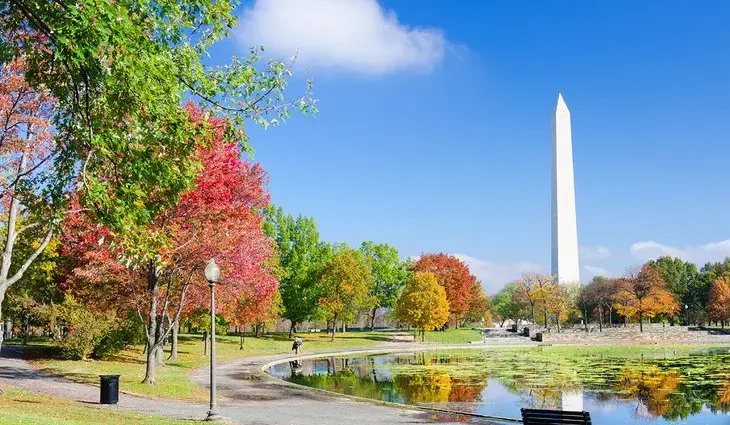Contents
Washington D.C. leads the pack when it comes to public parks, with over 20 percent of its area dedicated to green spaces. Whether you’re in town on business, popping in for a cheap weekend getaway, or visiting on a family vacation, D.C.’s parks provide a welcome respite from the bustle of this fast-paced city.
The city’s most famous park is the National Mall, which provides easy access to many of D.C.’s most popular tourist attractions and sightseeing destinations, from Smithsonian museums to the imposing Washington Monument. The nearby Tidal Basin offers even more things to see and do, including the opportunity to see the iconic cherry blossoms if you’re lucky enough to visit in March.
In addition to the more typical city parks, D.C. is home to expansive green spaces like the National Arboretum, that make visitors forget they are in the midst of an urban landscape. And, if you’re an animal lover, you’re in for a treat with a visit to the Smithsonian National Zoological Park, which is free for all visitors.
With this many options, it can be hard to know which to visit first. Find your starting point with our list of the best parks in Washington, D.C.
1. National Mall

You could spend the better part of a day exploring the National Mall, the District of Columbia’s most well-known green space and home to the most iconic D.C. monuments.
If you don’t have time to explore the whole park, be sure to at least visit the western end at the Lincoln Memorial. This is the best spot to properly admire the Washington Monument and Reflecting Pool, as well as the lovely trees and flowers that line it.
After visiting the Korean War Veterans Memorial just south of the pool, head to the other side to visit the Vietnam Veterans Memorial before proceeding east through Kingscott Meadow and past the pond in Constitution Gardens.
You will find the World War II Memorial at the eastern end of the Reflecting Pool, with its series of somber columns standing guard around an oval fountain. Beyond this is the German-American Friendship Garden, which sits beneath the towering obelisk of the Washington Monument, and to the north sits the White House and its grounds, including the Ellipse.
Although you may be able to approach the presidential residence, this large open space is often fenced off, and good photos of the building are difficult to get from this side.
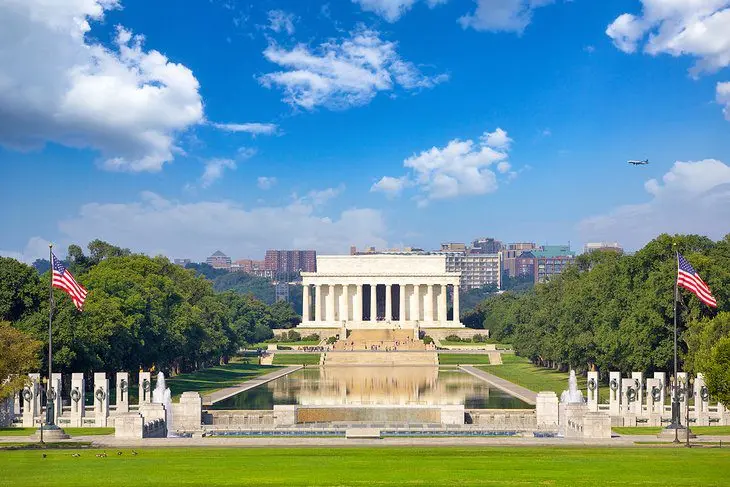
The remainder of the Mall to the east of the monument is mostly open grass with wide pedestrian ways and a thin line of trees at each side, but this is the easiest way to reach the Smithsonian museums that sit within and beside the park.
Museums along the northern side of the Mall are the National Museum of American History, the National Museum of Natural History, and the National Museum of African American History and Culture.
On the opposite side of the green is the Smithsonian Castle, the National Air and Space Museum, and the National Museum of the American Indian.
Other points of interest on and along the Mall include the United States Holocaust Memorial Museum, the Freer Gallery of Art, the Arthur M. Sackler Gallery, several excellent gardens, and the U.S. Botanic Garden Conservatory.
2. Tidal Basin Loop Trail
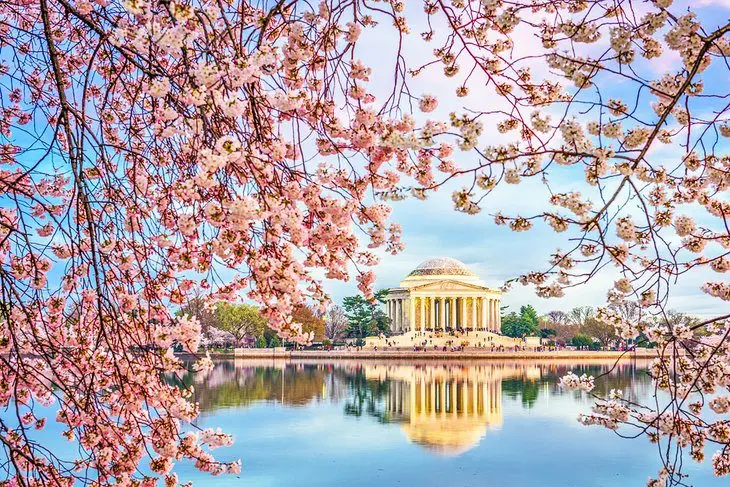
The Tidal Basin is a man-made holding pool filled by the Potomac River as the tide rises, which then empties into the Washington Channel as the tide goes out, flushing the sediment in the channel to keep it clear for ships. Although fascinating engineering, the basin itself is not the main attraction — it is the numerous landmarks surrounding it that make it a top destination, especially during the annual National Cherry Blossom Festival.
The Tidal Basin Loop Trail circles the water, with the path beginning and ending on the southern edge of the National Mall near the Washington Monument. Visitors start at the Japanese Lantern, a 350-year-old lantern made of granite that was a gift from the Mayor of Tokyo. Nearby is the site of the 1912 plantings — the first of the cherry trees that would become an iconic symbol of Washington D.C.

Next, you will approach the Franklin Delano Roosevelt Memorial, which is actually a series of stunning monuments accompanied by reliefs and sculptures that commemorate the president’s contributions to his country.
After passing the Japanese Pagoda and reading its comical origin, the next landmark is the Inlet Bridge, which passes over the gates that allow water to flow from the Potomac River into the basin. On the other side, the Jefferson Memorial is hard to miss, sitting within a massive Classical Roman rotunda.
After passing a copse of crab apple trees, but just before the Outlet Bridge, you will see the Indicator Tree — an enigmatic cherry tree of unknown origin that dependably blooms about one week before the rest of the cherry trees, signaling the impending explosion of pink blossoms. Beyond, along the northeast side of the water, are more than 2,500 Yoshino cherry trees that comprise the majority of the park’s trees.
Beyond these, but before the long bridge that brings you back to the start, is the Floral Library — not a collection of books but rather a carefully curated garden that displays different varieties of tulips side by side each spring. After the tulips have passed, they are replaced by hyacinths and other annuals that brighten the path.
3. Rock Creek Park
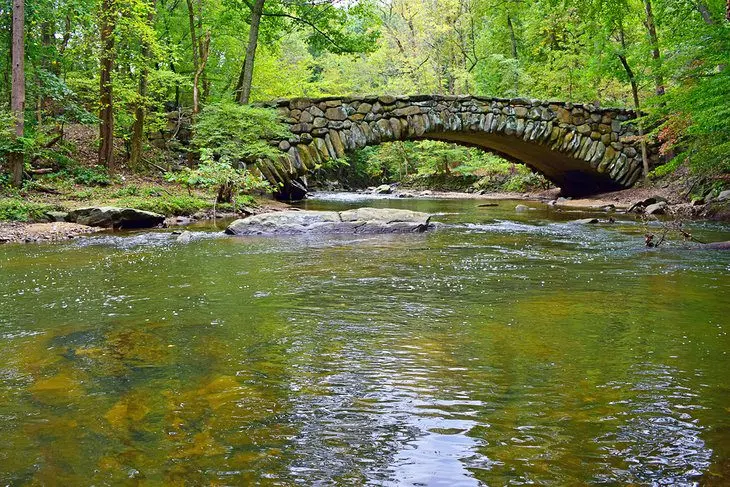
By far the largest of the city’s parks, Rock Creek Park occupies over 1,750 acres that stretch in a column from the northern corner of the city to the Smithsonian National Zoological Park. Named for the creek that snakes its way down the length of the park, you will find a huge variety of recreational opportunities here.
The main visitor center, Rock Creek Park Nature Center and Planetarium, is located near the center of the park, offering exhibits, kids’ programming, hiking information, and planetarium shows.
There are also plenty of things to do here beyond walking its numerous nature trails, many of which allow cycling. It’s home to recreational facilities that include a golf park, the Fitzgerald Tennis Center, an equestrian center, and soccer fields. You will also find numerous designated picnic areas throughout the park and a variety of trails for different fitness levels, including a quarter-mile paved trail that is wheelchair accessible.
Points of interest include the picturesque Boulder Bridge; Mountain View Overlook; and Peirce Mill, an operational grist mill built in the early 19th century.
Address: 5200 Glover Road NW, Washington, D.C.
4. Bartholdi Park (U.S. Botanic Garden)
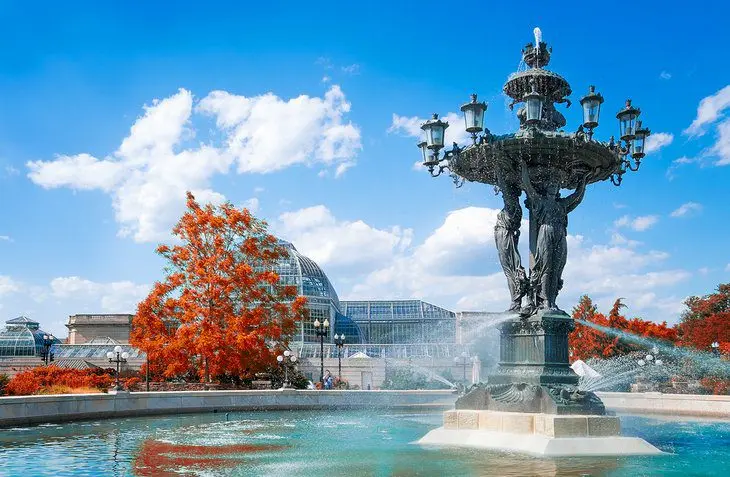
Just off the eastern end of the National Mall, across the street from the glasshouses of the U.S. Botanic Garden Conservatory, Bartholdi Park displays the U.S. Botanic Garden’s outdoor collections.
This park may only cover two acres, but the quality and variety of the botanic collections is impressive. In addition to beautiful ornamentals, like roses and other perennials, the park has many leafy trees with benches to rest upon in their shade.
The central feature of Bartholdi Park is its cast-iron fountain, named the “Fountain of Light and Water” but more commonly referred to simply as Bartholdi Fountain. Created in 1875 by Frederic Auguste Bartholdi, the central sculpture weighs over 15 tons and stands at a height of 30 feet tall. It features three sea nymphs holding a basin lit by a dozen lamps, encircling the figures of children splashing the water that pours from a crenelated tower above them. At the nymphs’ feet are turtles spitting water.
If you’re in the neighborhood after dark, be sure to check out the fountain while it is illuminated. This park has been recently updated to ensure that it’s fully accessible to visitors of all abilities.
Address: 245 First Street SW, Washington, D.C.
5. Georgetown Waterfront Park
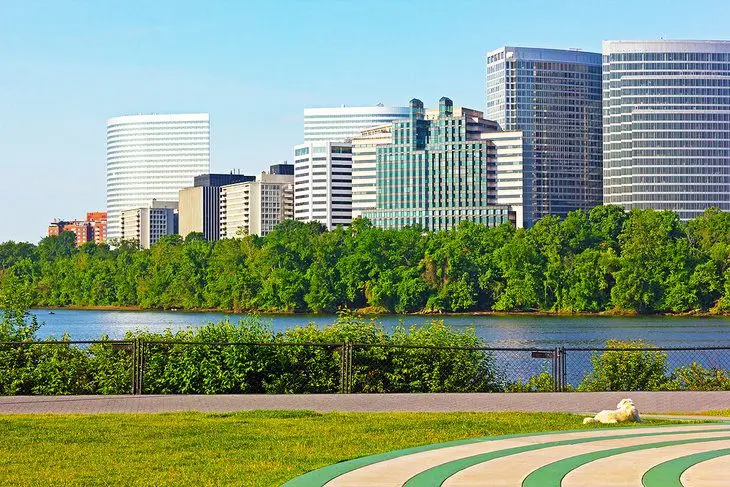
The Georgetown Waterfront Park occupies 10 acres along the banks of the Potomac River between 31st Street NW and 34th Street NW. It is a young park, opened in 2011, transforming a formerly industrial strip of land into a green space for all ages.
A series of accessible paths intersect throughout the park, with a dedicated thoroughfare for cyclists and skaters, which has a clear view of the water. The most popular spot in the park during summer is Percy Plaza, located on the eastern end of the park, home to a large spray fountain that welcomes kids of all ages to cool off on a hot day.
At the water’s edge in front of the fountain are a set of steps, originally designed for rowing regatta spectators but equally enjoyed by visitors just there to watch life go by on the river. Located at the other end of the park is a more peaceful landmark, a labyrinth designed for contemplation.
The park is also home to several eco-conscious elements, including the Bio-Edge that replaces old concrete retaining walls, rain gardens to prevent erosion, and lovely pollinator gardens to keep the bees at work. This park is well-lit, and you will find benches and seating throughout.
Address: 3303 Water Street NW, Washington, D.C.
6. Dumbarton Oaks and Dumbarton Oaks Park
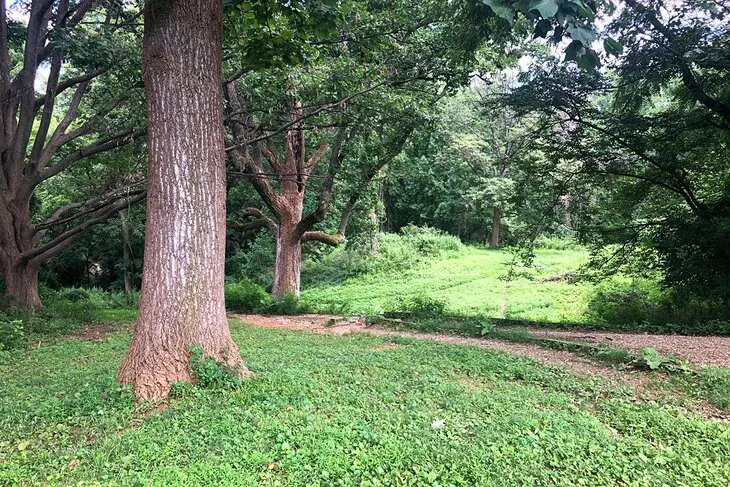
Between Georgetown and Embassy Row sits an irregularly shaped green space, its west half occupied by Dumbarton Oaks Park, and the east by Montrose Park. Both were once the estates of prominent landowners and are now open for the public to enjoy.
The gardens of Dumbarton Oaks were specifically designed to be an urban oasis, and now serve as a working research facility for Harvard University’s Garden and Landscape Studies, and also include lovely areas where you can admire the flora, as well as contemporary art installations.
The Dumbarton Oaks Museum sits near the park, and if you have the time, stop in for a tour of the mansion’s stunning interior.
Montrose Park is home to the former estate of Richard Parrot, a wealthy rope-maker who purchased the plot in 1804. Although the mansion is long gone, the “Ropewalk” remains as a reminder of the early days, when the ruler-straight, tree-lined path was actually used to manufacture rope. You can also explore the Boxwood Gardens, and find a nice playground in the park, as well as tennis courts.
Rock Creek runs along the eastern border of these parks.
7. US National Arboretum
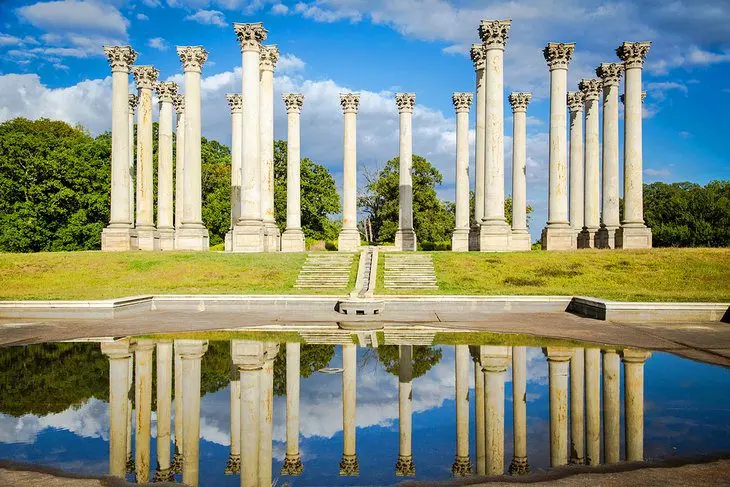
The U. S. National Arboretum spans 446 acres in northeast Washington D.C., home to flowers, trees, and everything in between. If you are lucky enough to be visiting near the end of April, you’ll be stunned by the wall of color on the Glenn Dale Azalea Hillside, when tens of thousands of blossoms cover the slopes of Mount Hamilton.
You will find blooming plants all year-round in the Asian Collections, with the camellias dominating from mid-autumn through early spring. The full collection covers 13 acres and has several themed areas, including a Chinese Valley, Korean Hillside, and Japanese Woodland.
Trees of all sizes make their home here, the smallest living at the National Bonsai & Penjing Museum. Starting with a gift of 53 trees from Japan, the collection now houses more than 300 expertly curated specimens.
Outdoors, the Grove of State Trees includes groupings of trees representing all 50 states, as well as the District of Columbia, and the Gotelli Conifer Collection displays a variety of evergreens. The Arboretum also has the National Boxwood Collection, which features more than 180 taxa, a dogwood collection, and a lush fern valley.
The Arboretum is also home to many gardens, featuring historic roses, perennials, annuals, herbs, and wildflowers. This is also the site of the Washington Youth Garden, a working garden that hosts school groups and families as the kids work together to grow food while learning about gardening, nutrition, and horticultural science.
An unexpected landmark on the property is the National Capitol Columns — a set of Corinthian sandstone columns that briefly supported the dome of the Capitol Building until they were quickly replaced by larger, stronger ones that could support the full weight of the iron.
A visit here is easy on your wallet — the arboretum and the museum are open to the public free of charge, including the parking.
8. Smithsonian National Zoological Park

No trip to D.C. is complete without a visit to the Smithsonian National Zoological Park, a free attraction that is fun for all ages but especially popular with families.
The zoo is located in the Woodley Park neighborhood just south of Rock Creek Park, covering a total of 163 acres and home to 2,700 animals representing 390 species. The National Zoo is best known for its successful giant panda breeding program, and these fuzzy residents are the star of the Asia Trail, also home to the clever red panda, clouded leopards, and sloth bears, among others.
You will also want to keep an eye out for the Elephant Trail, a habitat that is home to five Asian elephants and provides plenty of space for them to roam, play, and splash. The Great Cats exhibit includes African lions and Sumatran tigers; and the primates exhibit includes a Great Ape House, home to gorillas and orangutans; Gibbon Ridge, with its siamangs and white-cheeked gibbons; and Lemur Island, home to three varieties of the adorable critter. The zoo is also home to a reptile center, an aviary, a small mammal house, and a kids’ farm.
Although the park is free, you do need to have an entry pass to get in, which should be reserved online at least four weeks in advance. If you’re considering a last-minute visit, there are a limited number of same-day passes available. You can also pre-purchase parking passes, which, unfortunately, are not free.
Address: 3001 Connecticut Ave., NW Washington, D.C.
Map of Parks in Washington, D.C.
Washington – Climate Chart
| Average minimum and maximum temperatures for Washington, DC in °C | |||||||||||
| J | F | M | A | M | J | J | A | S | O | N | D |
| 6 -3 | 8 -1 | 13 3 | 19 8 | 24 13 | 29 18 | 31 21 | 30 21 | 26 17 | 20 10 | 14 4 | 8 0 |
| PlanetWare.com | |||||||||||
| Average monthly precipitation totals for Washington, DC in mm. | |||||||||||
| 82 | 67 | 91 | 70 | 97 | 80 | 93 | 87 | 96 | 82 | 77 | 78 |
| Average monthly snowfall totals for Washington, DC in cm. | |||||||||||
| 16 | 16 | 4 | 0 | 0 | 0 | 0 | 0 | 0 | 0 | 3 | 8 |
| Average minimum and maximum temperatures for Washington, DC in °F | |||||||||||
| J | F | M | A | M | J | J | A | S | O | N | D |
| 42 27 | 47 30 | 56 37 | 66 46 | 75 56 | 84 65 | 88 70 | 86 69 | 79 62 | 68 50 | 57 40 | 47 32 |
| PlanetWare.com | |||||||||||
| Average monthly precipitation totals for Washington, DC in inches. | |||||||||||
| 3.2 | 2.6 | 3.6 | 2.8 | 3.8 | 3.1 | 3.7 | 3.4 | 3.8 | 3.2 | 3.0 | 3.1 |
| Average monthly snowfall totals for Washington, DC in inches. | |||||||||||
| 6.2 | 6.3 | 1.6 | 0 | 0 | 0 | 0 | 0 | 0 | 0 | 1.0 | 3.1 |










